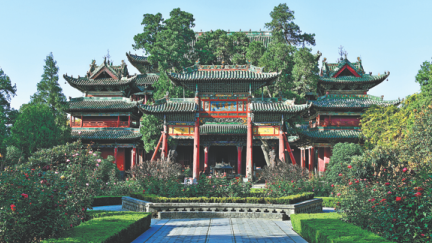General Guan Gong revered in hometown of Haizhou for military valor
Updated: 2021-11-26

The Guandi Temple in Haizhou is the largest temple in China dedicated to the worship of Guan Yu. [Photo by Li Ningbo for China Daily]
Just as Confucius has been regarded as a sage of Chinese culture for more than 2,500 years, Guan Gong has been deemed a sage of military valor and enjoys a similar status among worshippers.
The worship of Guan is so prevalent throughout China that a saying goes: "Every village has a temple of Guan Gong."
Guan Gong is a reverential term of address for Guan Yu, a general in the period spanning the late Eastern Han Dynasty (25-220) and the Three Kingdoms (220-280).
Guan was one of the most prominent generals of his time serving under the warlord Liu Bei. He played a significant role in the civil war that led to the collapse of the Eastern Han Dynasty and the establishment of the state of Shu Han, of which Liu was the first emperor.
Liu was said to be a descendant of the Han royal family and his state of Shu Han was regarded as a legitimate extension of the previous dynasty. This confirmed Guan as a warrior for a righteous cause and distinguished him from other generals in that period.
Known for his exceptional valor and loyalty, he was deified as Guandi or Emperor Guan.
This elevation led to nationwide worship of Guan. The influence of Guan has also reached more than 100 countries and regions with the emigration of Chinese people over the centuries.
Temples of Guan have been built in China and overseas. A statue of Guan can often be found in residences, shops and restaurants owned by Chinese, with burning candles and incense surrounded with fruits as offerings.
However, residents in Shanxi province, especially in Guan's hometown of Haizhou in the city of Yuncheng, are among the most fervent believers.
Among the countless temples of Guan across China, the one in Haizhou is the most typical, the largest, best preserved and most skillfully constructed.
It is also the most famous among all Guan Gong temples. Surrounded by a huge wall, accessible by nine gates and consisting of a huge complex of ancient structures, the temple is comparable to an imperial palace complex like the Forbidden City in Beijing.
The largest building in this complex is the Hall of Spring and Autumn. The main statue in the hall is a sitting Guan Yu reading Spring and Autumn, a historical classic compiled by Confucius. It was said Guan drew much inspiration from Confucius' classics to cultivate his virtues of valor and loyalty.
Li Ningbo contributed to this story.



